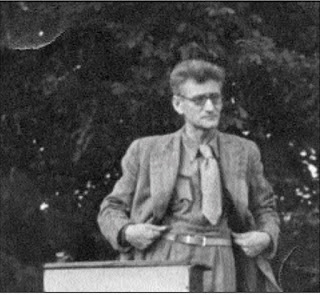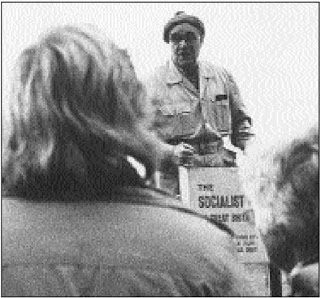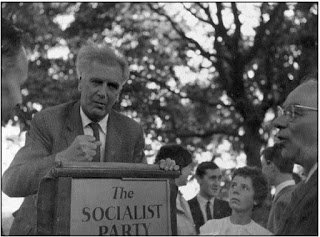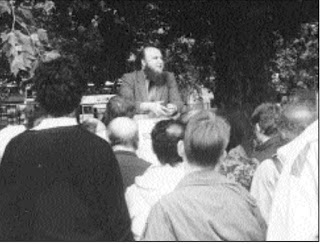On the stump
A short history of SPGB outdoor speaking
When the name of the Socialist Party is mentioned something that springs to mind for many is outdoor public speaking. For much of its political life the SPGB has relied on outdoor meetings for a key part of its propaganda against the capitalist system, these acting as crucial aids to recruitment alongside the Socialist Standard, leaflets, pamphlets, indoor meetings and debates. Indeed, the proportion of Party members citing outdoor meetings as the means by which they first came into contact with the Party was significant until the 1950s when this form of propaganda went into something of a decline.
During the first few years of the Party’s existence propaganda was mostly indoor, outside speaking only being undertaken in the summer months. In these early years the Party was almost entirely confined to London and its environs, with only Manchester in the provinces holding regular meetings, and from early 1908 a yearround London outdoor rota (the “Lecture List”) was established. A range of stations were used across the capital increasing to no less than 22 sites on Sundays during the summer of 1914, before the outbreak of war. Street corners, especially outside pubs, were the favourite locations. Few of these sites were used exclusively by the Party and some had been in continuous use since the 1880s.

Sammy Cash
Sunday’s best
Sunday was the most important day for outdoor meetings, although on most other nights a Party speaker would be on the stump somewhere in the capital. The pre-war Sunday meeting was an integral part of working class life. Typically the father would be evicted from the house while the Sunday meal was prepared. Since the pubs were closed he drifted around the streets looking for anything to entertain him, which is what the street meeting typically did. After his meal he might visit the local during the afternoon for some liquid refreshment. Afterwards speakers would again be on hand. The typical starting times of the street meeting were therefore 11.30 a.m. and 7.30 p.m. Meetings in public parks were usually held in the afternoon (3.30 or 4 pm), for a rather more ‘refined’ clientele taking their Sunday afternoon stroll.
The outdoor Party meeting was managed by the local branch whose ‘turf’ the site was on and the duty of host (meeting chairman) was highly competed for. In March, 1908, for example, a dispute arose over the ‘ownership’ of the Clapham Common meeting. Both Battersea and the short-lived Clapham branch claimed the meeting and tempers frayed so much that five Battersea members went so far as to hand in their resignations.
The big names of the era, most notably Jack Fitzgerald and Alex Anderson – whose main stamping grounds were Battersea and Tottenham respectively – featured prominently amongst the speakers but there was a wide range of others, many now forgotten (as with the membership generally there was a high degree of turnover during these years). It was by no means uncommon for a speaker to do two ‘shifts’, though three talks in one day would have been very rare even for Anderson.
While no record exists of what exactly was said at outdoor meetings during this era it can be safely assumed from accounts of the time that the speechmaking was heavy on rhetoric, working perhaps just as much on an emotional as an intellectual level, and was most likely lengthy and littered with stock quotations from key texts on political theory and Marxian economics. The real importance of such meetings lay not just in the speech itself but in the small groups of young workers that gathered afterwards to argue points raised. In this way outdoor speaking acted as a valuable spur to working class intellectual self- development.

Harry Young
All this came to an end with the outbreak of the First World War. Within a short time outdoor meetings stopped as a result of harassment by pro-war ‘jingoes’. The last Party listing published during this period (December 1914) sarcastically noted that “Owing to various circumstances, including the peculiarly British sense of fair play of our opponents, the Party’s Lecture List is considerably curtailed this month.” The following month outdoor meetings ceased altogether.
In the summer of 1919 regular outdoor meetings resumed in London, although with a much lower level of activity than before the war. In August of that year there were just six Sunday stations. Only four of these proved to be of any long-term use: Clapham Common, Finsbury Park, Victoria Park, and West Green Corner in Tottenham. During the mid-1920s these were the only locations in the capital operated by the Party but towards the end of the decade a modest revival occurred with a few pre-war venues, such as Prince of Wales, Harrow Road, and several new sites, such as Beresford Square, Woolwich, coming into use. It was not until after the 1929 crash though that more widespread outdoor activity returned. The early 1930s saw a multitude of sites brought into use, the most important being the Cock Hotel at East Ham, Whipps Cross at Leyton and Brockwell Park. A peak was reached during this period in July 1935 with twelve Sunday stations in use and a further four on a Saturday.
Interestingly, the latter part of the 1930s saw something of a decrease in regular outdoor meetings. To some extent this was due to increasing motor traffic, which rendered certain street locations unusable but was also due to a relative (though temporary) shortage of outdoor speakers, this in part resulting from the introduction of more stringent requirements for those wishing to take the platform on behalf of the Party (the introduction of the so-called ‘New Speakers Test’). At this time the Party increasingly moved its attention to propaganda in parks, the focus being on five open spaces: Brockwell Park, Clapham Common, Finsbury Park, Hyde Park and Victoria Park.
Of these Hyde Park was king. For the SPGB the rise of Hyde Park was rapid as although meetings had briefly been held here in pre-war days and in the late 1920s these had not always been a huge success, and so it was not until 1937 that Speakers’ Corner again entered the Party’s itinerary. Hyde Park became fertile ground and by the summer of 1939 three ‘shifts’ were operating on a Sunday.
Prolific
The most prolific speakers of this era were Bob Ambridge, the idiosyncratic Sammy Cash, Solomon Goldstein (remembered by those in the Party as a particularly able exponent of Marxian economics), Clifford Groves, Sid Rubin and the grizzled old Canadian orator Charlie Lestor – all of them hugely capable outdoor speakers, though Tony Turner, with his deep rasping voice and thunderous delivery, was the most remarkable of all. Turner’s greatest moment was on the day war broke out, when in Hyde Park he took and held a crowd of ten thousand or more as he railed against the impending imperialist slaughter.

Clapham Common
Cock Hotel, East Ham
East Street, Walworth
A further eight sites, including the long-lived Jolly Butchers Hill venue, were used on Saturday with several others – such as Trebovir Road, Earl’s Court – used on week-nights. The most productive was always Hyde Park: these meetings alone accounted for over 10 percent of the Party’s new members during the 1940s. Most of the orators who learnt to ply their trade in the Party during the 1930s continued to be active, Turner remaining a star turn, along with Wilmott, Dawe and a band of other speakers who had joined in the years before the war and who brought with them a characteristic platform style distinguished by quick-wittedness, aggression and self-confidence.
 |
| Steve Coleman |
These last few outdoor speaking venues took a surprising time to die off and it was not until 1967 that the SPGB held its last regular street meeting in London. This left occasional meetings at Earl’s Court, the regular weekday City meetings – such as those at Tower Hill – which lasted until 1979, and Hyde Park, where Harry Young, Steve Coleman and others habitually mounted the Party platform on Sundays and which still sees regular if ad hoc use today.
Bob Ambridge
The outbreak of the Second World War – in contrast to 1914 – did not bring an end to outdoor propaganda, even if for a time it was severely curtailed as a result of the ‘blackout’ and the Blitz. Until mid-war the parks continued to be the main venues, though as the war progressed street meetings resumed their importance. A big explosion of meetings then came after the end of the war and by 1949 the SPGB was holding over a thousand outdoor meetings a year. During this period regular Sunday meetings in London were held at:
Beresford Square, Woolwich
Clapham Common
Cock Hotel, East Ham
East Street, Walworth
Finsbury Park
Heron Court, Richmond
Hyde Park
Islip Street, Kentish Town
Regents Park
Warren Street station
West Green Corner, Tottenham

Steve Coleman
A further eight sites, including the long-lived Jolly Butchers Hill venue, were used on Saturday with several others – such as Trebovir Road, Earl’s Court – used on week-nights. The most productive was always Hyde Park: these meetings alone accounted for over 10 percent of the Party’s new members during the 1940s. Most of the orators who learnt to ply their trade in the Party during the 1930s continued to be active, Turner remaining a star turn, along with Wilmott, Dawe and a band of other speakers who had joined in the years before the war and who brought with them a characteristic platform style distinguished by quick-wittedness, aggression and self-confidence.
An important innovation around this time was the popular weekday lunchtime meetings at Tower Hill, Finsbury Pavement and Lincoln’s Inn Fields, with the latter being perhaps the most rewarding in terms of new members. Outdoor speaking was a notable feature of the election campaigns during the immediate post-war era too. For the 1945 Paddington election, meetings were held every night outside the Prince of Wales, Harrow Road, and most nights at a selection of venues throughout the area, supplementing the big indoor meetings at the Metropolitan Theatre.
But if the 1940s saw continuous and rapid expansion in the SPGB outdoor speaking scene, the 1950s saw just as speedy a decline, especially in London, though Glasgow and some other provincial venues bucked the trend for longer. One by one the old haunts were shut down until by the end of the decade just four Sunday venues remained in the capital: Hyde Park, East Street in Walworth, Beresford Square in Woolwich and Clapham Common. In addition two Saturday stations, Rushcroft Road in Brixton and Castle Street, Kingston, were retained.
These last few outdoor speaking venues took a surprising time to die off and it was not until 1967 that the SPGB held its last regular street meeting in London. This left occasional meetings at Earl’s Court, the regular weekday City meetings – such as those at Tower Hill – which lasted until 1979, and Hyde Park, where Harry Young, Steve Coleman and others habitually mounted the Party platform on Sundays and which still sees regular if ad hoc use today.
Outside London
Outside the capital SPGB outdoor meetings have been a feature at a large number of venues in towns and cities across the UK – with a peak in the 30s and 40s. Glasgow was a city where the Party’s outdoor speaking activities were significant from the 1920s onwards, and they continued to flourish much later than in London, especially in The Barrows, West Regent Street, Blythswood Street and Exchange Square. Glasgow branch produced many fine outdoor orators but Alec Shaw was truly outstanding.
Other regular provincial venues included Edinburgh (where The Mound was a regular venue into the 1990s), Bristol, Birmingham, Nottingham, Sheffield, Southend and even Welwyn Garden City for a time. A number of cities in the Midlands and the North including Coventry and Bradford saw periodic SPGB outdoor speaking activity, with many others seeing flying visits from Party speakers trying to drum-up interest. In the North of England though, only Manchester proved to be really consistent territory for speakers on the outdoor platform, with Baritz, Maertens and others regularly holding forth at Stevenson Square and Platt Fields.
Looking back, the reasons for the sad decline of street-corner meetings are not hard to find. It is no surprise that the start of the fall-off in these in the early 1950s, especially in London, coincides almost exactly with the removal of petrol rationing and in one sense street meetings during and immediately after the Second World War were a revival of a form already under sentence of death: as has been indicated they had been noticeably curtailed in favour of both indoor meetings and meetings in parks even in the late 1930s.
The decline of park meetings though is perhaps more complex. Local authority pressure to ‘tidy up’ the open spaces may well have been one reason and the related decline of street meetings another, as people simply got out of the habit of listening to – and interacting with – outdoor orators on a daily or weekly basis. In terms of entertainment, competition from radio, and later television, was obviously another factor, as was – most crucially of all – the role of passive receiver of information foisted upon the working class by the entire apparatus of the modern mass media.
KEITH SCHOLEY
